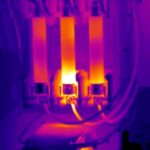The vibration signature of a machine is the characteristic pattern of vibration it generates while it is in operation. It has been shown many times over that the vibration of an operating machine provides far more information about the inner workings of that machine than any other type of nondestructive test. A bearing that has a small developing fault will cause a tell-tale change in the machine’s vibration, as will a weight imbalance condition, a shaft or coupling misalignment, or any of a myriad of other faults.
With virtually all building owners and operators seeking reductions in plant maintenance manpower, as well as greater efficiency of all maintenance practices, the value of vibration analysis has become more obvious in recent years. Vibration analysis provides a thorough evaluation of all moving parts of one’s plant equipment and machinery, can identify root causes as well as specific machine faults, and most importantly, is capable of correctly identifying those machine faults when or actually before they first appear.
Vibration analysis, properly applied, allows the detection of small developing mechanical defects long before they become a threat to the integrity of the machine, and thus provides the necessary lead time to suit the needs and schedules of the plant operators / management. In this way, plant management has control over the machines, rather than the other way around. Properly applied, vibration analysis offers the following significant benefits:
| Transition from “Run to Failure” mode or preventive to Predictive Maintenance | |
| Acceptance testing of new equipment delivery and installations | |
| Quality assurance of major overhaul repairs | |
| Implement Proactive maintenance practices | |
| Avoid or minimize unnecessary calender-based maintenance | |
| Decreased or eliminated unscheduled machine downtime | |
| Improved maintenance management by directing resources on a need basis | |
| Energy savings |









